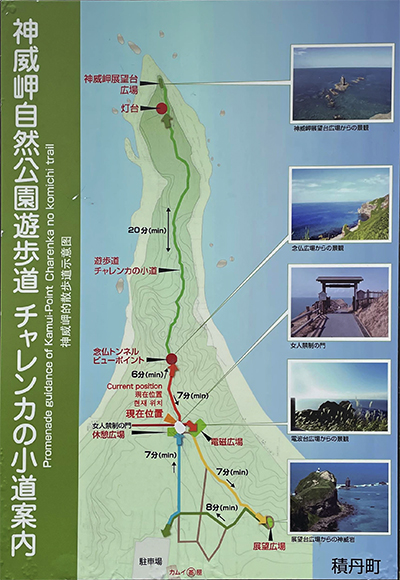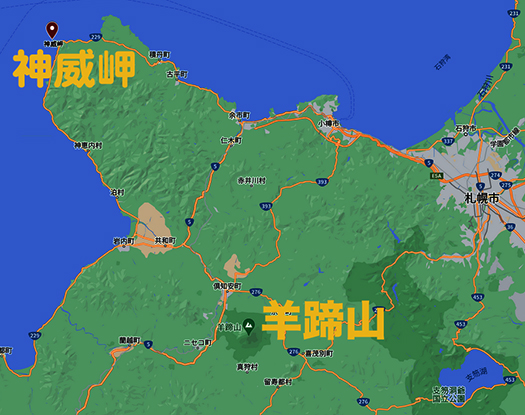


縄文の約3,000年前とされる羊蹄山麓の環状列石遺構の見学から触発されての古代日本と北海道島の歴史探訪。基本交通路は船舶による交通手段の時代。阿倍比羅夫は、諸説はあるけれど北海道島に「後方羊蹄」という地名痕跡を確実に残している。
北海道人としては、しかしその後、江戸期まで日本史との関わりの痕跡が途絶えることが不可思議。いくつかの伝承や文献記録などから、推理するくらいしか手掛かりに乏しい。
伝承としては「義経伝説」があって、写真の積丹・神威岬を限界としてこの地以北が「女人禁制」とされたことが記録されている。義経が頼朝からの追捕の手を逃れて蝦夷地に逃避行したという「伝説」。最後は大陸に逃れて、その後ジンギスカンになったという荒唐無稽の伝承。その一節に、この神威岬にまつわるアイヌの族長の娘との悲恋物語。義経と恋仲になった娘は、追っ手から逃れるためにこの神威岬から出発した義経を追って、荒波にさらわれて命を落としたとされる物語。
ながく北海道島が日本史の表面から姿を消している時期。平家物語の語り部として全国の村々の祭りなどの機会に琵琶の伴奏つきの物語を語った法師たちから、その内容を受け取ったその時代の大衆が、判官びいきという心象を持ったことは蓋然性が高い。そういう心理が多様な義経伝承を生んだものだろうか。
ニセコ地域からの帰り道、積丹半島をぐるっと回って帰ることにした。

神威岬は1−2回は来ているけれど、今回はまことに「風極」とでも言える強風。日高の襟裳岬でも体験したけれど、大人でも立っていられないくらいで、子どもたちはふざけていると実際に風に飛ばされて転んだりしていた。岩礁地帯で岬自体、半島自体が巨大な造岩活動の凄まじさを表現する地形と、この風の強烈さで江戸期くらいまで開発が遅れたのかという体感を持った(笑)。
実際に「女人禁制」としたのは、江戸期の松前藩による海産資源・経済利権の秘密保持が目的だったのだろうけれど、このことが北海道開拓進展に桎梏となったことも事実。神威岬から先の石狩湾以北に行くには舟しかなかったので岬を通行禁止にされると女性は石狩以北には行けなかったのだ。女人禁制とは、それ以北に「定住するな」「出稼ぎしか認めない」という宣言であり、地域開発するという意思はどこにも見えず、ただただ、自藩の交易利得にしか価値感を持っていない地域政権。事実上の松前藩による「開拓禁止」政策だった。
今日の北海道と江戸期の松前藩にはどのようにも「継承性」がない。たぶん全国の大名領地と明治以降の関係性の中で、北海道ほど断絶が際だっている地域もないだろう。「直轄支配」時期のこともあり、むしろ江戸幕府の方が開明的に北方防衛意識を高く持って北海道島の未来と向き合っていた。松前藩が南方の薩摩のような藩であったら、その後の日本史は大きく変化した可能性がある。
English version⬇
Cape Kamui, a difficult point on the Japan Sea route and forbidden to women, and the development of Hokkaido
The Matsumae Clan of the Edo period delayed the development of the Shakotan Peninsula north of Cape Kamui by taking advantage of a legend about Yoshitsune. A clan that clung to its marine products trading interests and had no regional development policy. The Matsumae Clan
A historical exploration of ancient Japan and the island of Hokkaido, inspired by a visit to the ringed stone remains at the foot of Mt. Yotei, which are believed to date back about 3,000 years to the Jomon period. The basic transportation route was by ship in those days. Abenohirau definitely left traces of the place name “backward Yotei” on the island of Hokkaido, although there are various theories.
As a Hokkaido native, however, I find it strange that traces of the area’s connection to Japanese history ceased after that, until the Edo period. There are only a few clues that can be deduced from folklore and written records.
There is a “Yoshitsune legend” that records that the area north of Cape Kamui, pictured in the photo, was forbidden to women. The “legend” tells of Yoshitsune’s escape to Ezo, escaping from Yoritomo’s pursuit. The wild folklore says that he finally escaped to the continent and subsequently became Genghis Khan. In this passage, there is a tragic love story about the daughter of an Ainu chief who was in love with Yoshitsune. It is said that the daughter, who fell in love with Yoshitsune, was snatched away by a stormy sea and lost her life in pursuit of him as he departed from Cape Kamui to escape his pursuers.
It is highly probable that, at a time when the island of Hokkaido had long disappeared from the surface of Japanese history, the public of that era, who received the content of the tale, had a mental image of a favoritism toward the priests who told the story with biwa accompaniment at festivals and other occasions in villages across the country as storytellers of the Heike tale. Such a mentality may have given birth to the diverse folklore of Yoshitsune.
On the way back from the Niseko area, I decided to go around the Shakotan Peninsula.
I have been to Cape Kamui once or twice, but this time the wind was so strong that it could be described as a “wind pole. Even adults could not stand up, as we experienced at Cape Erimo in Hidaka, and children were actually blown away by the wind and fell down when they were joking around. The cape itself is a rocky reef area, and the cape itself and the peninsula itself have a topography that expresses the tremendous rock-making activity, and I had the feeling that the development of the area was delayed until around the Edo period because of the intensity of this wind (laugh).
The reason for the “no women allowed” policy may have been to maintain the secrecy of the Matsumae clan’s marine resources and economic interests during the Edo period, but it is also a fact that this policy was a deterrent to the development of Hokkaido.
The prohibition of women was a declaration that “no settlement” or “only migrant workers” would be allowed north of the boundaries of Hokkaido, and the regional administration had no intention of regional development, but only a sense of value for its own trading interests.
There is no “inheritability” in any way between today’s Hokkaido and the Matsumae clan of the Edo period. Perhaps no other region in Japan has such a remarkable disconnect between the feudal lords’ domains and their relationship with each other since the Meiji era as Hokkaido. Because of the period of “direct rule,” the Edo shogunate faced the future of the island of Hokkaido with a high awareness of northern defense in a rather open-minded manner. If the Matsumae clan had been like Satsuma in the south, the subsequent history of Japan could have been very different.
Posted on 5月 9th, 2023 by 三木 奎吾
Filed under: 日本社会・文化研究







コメントを投稿
「※誹謗中傷や、悪意のある書き込み、営利目的などのコメントを防ぐために、投稿された全てのコメントは一時的に保留されますのでご了承ください。」
You must be logged in to post a comment.